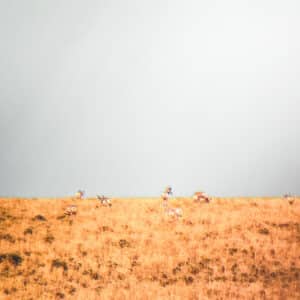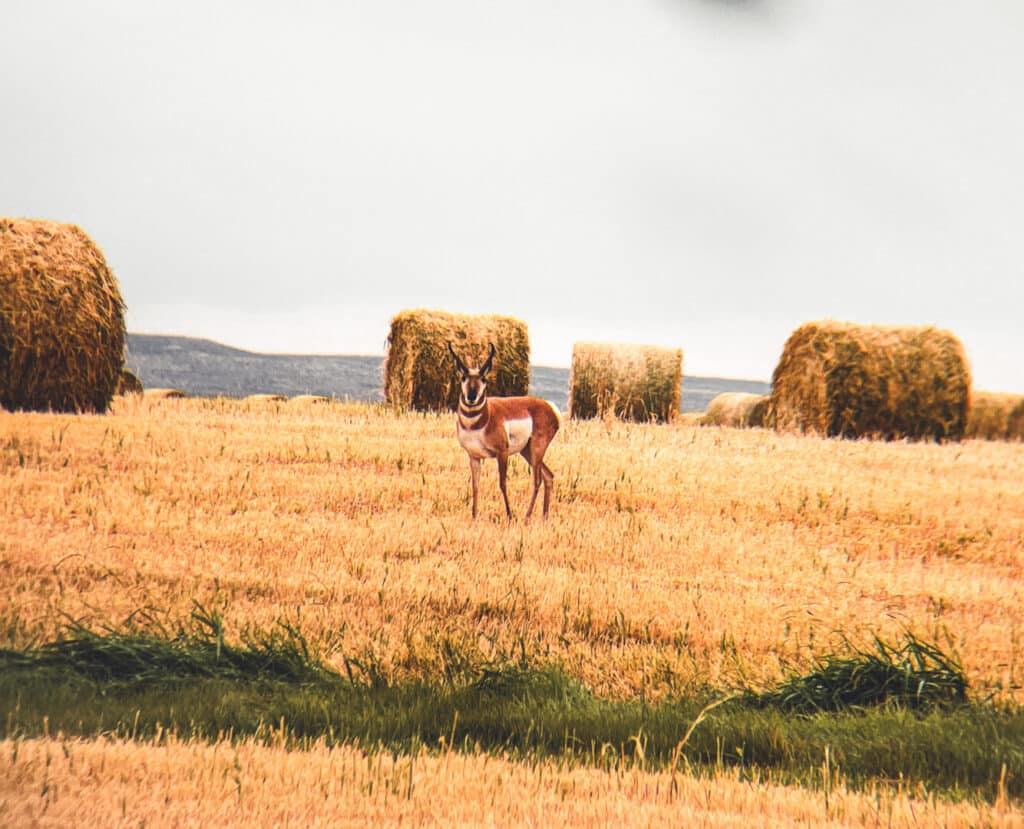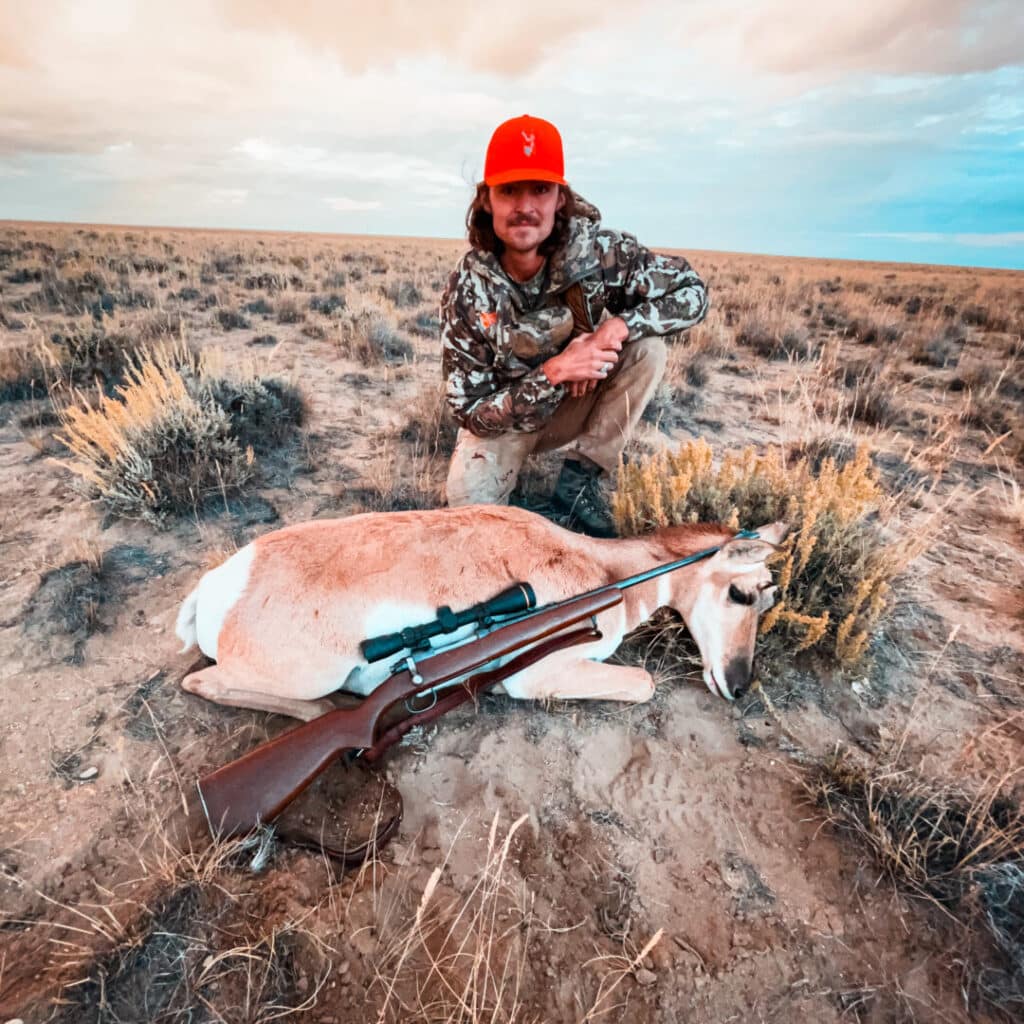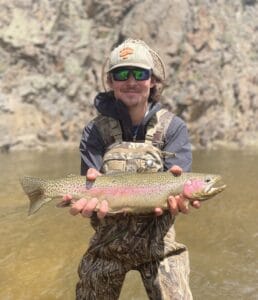EDITOR'S NOTE: This hunt occurred in fall of 2022. Since then, this pronghorn herd saw impacts to their numbers from the harsh 2022-2023 winter and there are no pronghorn doe tags in the area. If you would like to see their numbers rebound quickly, please consider getting involved with the Sublette Pronghorn Migration Corridor Designation.
| By Jake Rullman, Conservation Ambassador
When I first moved to Wyoming, I was immediately enamored with Pronghorn as a species. Their bug eyes and strange hooked antlers were vastly different from any critter that I had grown up around in Tennessee. The contrasting colors of their coat paired with the open country they lived in along with the ease and speed of which they travelled across increased my intrigue and fed my imagination.
After living in Wyoming long enough to gain my residency, acquiring a tag came within reach; however, hunting Wyoming's pronghorn felt further from reality than ever before. When the time to enter the draw rolled around, I thought the system would be easy but was met with a language barrier that rivaled the clash of modern English and its ancestral language roots. Luckily, I was able to consult a dear friend who was a seasoned translator, and together we found a doe pronghorn tag with decent draw odds. The way I saw it, it was impossible to draw, and I had no real chance. I completely forgot I even applied and decided I would just focus on general deer and elk.
A SUPRISE IN THE MAILBOX
One day in June, when unwinding after work I decided to check the overflowing mailbox I had been neglecting for the better part of two weeks. I lackadaisically sorted through the oversized stack of bills, ads, more bills, and a WGFD envelope and … “wait did that say WGFD”? Suddenly there in front of me lay a doe pronghorn tag, and it had MY name on it. Initially, I thought, “I am from Tennessee, what do I know about hunting pronghorn in the sagebrush country of Wyoming? I am way over my head.” Then, somewhere amidst the influx of worry and doubt, I said to myself “Pronghorn antelope… Heck, I can do that!”
The tag that I drew was a population control area; it was mostly ag fields where the pronghorn population was doing a number on the local crops the landowners relied on. Because of this, the Wyoming Game and Fish Department worked with the local landowners to create a tag to help mitigate the problem. This partnership was especially helpful to me because WGFD provided contact information to farmers who actually wanted you to hunt their property.
NO EASY TASK
When the time finally came for me to go to my unit, I had taken off three whole days from work so that I could drive down to the hunt area, park my jeep on a nice section of BLM, set up camp, and hand pick myself a nice fat alfalfa fed doe to put in my cooler and take home.
Easy right? Nope.
That evening I was mostly just glassing and scouting, gun in hand with no intention of shooting a pronghorn. I could have just gotten lucky you never know. The number of viable critters in the area was much higher than I would have ever imagined, which boosted my already high ego. After glassing up a handful of different herds of these beautiful bug-eyed goat deer, I decided I would attempt to put a stalk on the closest group to see how close I could get before the sun went down. The stalk came to no avail, but I was not worried. That night I slept like a well-fed baby, dreaming of all the meals that I would cook with doe that I would harvest with ease first thing in the morning. Or so I thought.
I had called a plethora of landowners, but not one of them had a doe pronghorn on their property, only beautiful bucks. In fact, none of the properties with pronghorn that I had glassed up were the ones that I had acquired permission from. They were either the neighbors or in the next area over in which my tag was invalid. “No Problem,” I said to myself. “I’ll just knock on doors and find more phone numbers on Yellow Pages.”

Well, the doors I knocked on either said no or looked unwelcoming to strangers—especially strangers from out of state with a strange accent asking to wander their property with a loaded gun. The same went for the phone numbers. Landowners either kindly said, “No we don’t allow hunting,” “You can try but there’s no antelope here,” or just didn’t answer. All except for one kind gentleman. This fella was nice enough to let me hunt not just one but several properties that he owned, and one of them bordered a large tract of BLM land. It was the perfect scenario. There was no way in my mind that I was walking away from this stretch of property without filling my tag.
The two properties were separated by one small country road. The kind with no lines and dried out cracks that seemed to cry for moisture. I parked on the same side of the road as the farmhouse, but in a separate driveway that led to an uncut pasture. The reason I chose to park there was because the field opposite is where the desired critters were located. This field was littered with pronghorn; there were plenty of haybale rounds scattered throughout the field that made for excellent cover. The far end bordered a large tract of BLM that happened to house the does I was eyeing. The only obstacle was the seemingly endless number of pronghorn bucks that were lounging in the comfort of the hay bales I was trying to sneak through. If I had an antelope buck tag in my pocket instead of doe/fawn, I would have been in heaven, and I do not believe I would have been able to bring myself to pass on any of those fine animals.
At first, I tried to wait it out behind a large comfortable hay round to see if the does would join the bucks in the field or if the opposite would happen and they would congregate on BLM.
GETTING SNEAKY
I decided I may as well try to navigate the maze of haybales and bucks. I set off, and I was sneaky. I crawled between bales with the stealth of a snake slithering through knee-high grass in pursuit of an oblivious cottontail rabbit.
The further I navigated through the field, the closer I got to the does, and the less careful I became. It got to the point where each time I came to a new haybale I checked my range: 400yrds, 350yrds, 300yrds. I rested my rifle up on a perfect bale and lined up a nice doe, but I was uncomfortable with the distance. I pulled it off the hay and went back to crawling, and I carelessly crawled right into a deeply alarmed pronghorn buck. I don’t know who was more frightened or whose alarmed sound scared the rest of the herd more: his snort or my shout. He scared me so badly that I believe my heart forgot how to do its job for a moment. By the time I got my bearings, they were dang near over the hill and in the next town.

I was defeated. I ran this herd out of the county, and I had a long lonesome walk back to the jeep where I would think of everything I did wrong. By the time I got back, I was so mad at myself I couldn’t see straight. I was ready to quit. I was tired, frustrated, and hungry. My mouth instantly watered. I broke out my camp stove, cooler, chair, and got cooking. I laughed at myself for thinking of calling it quits and went back to the drawing board. Seeing as how my foolish actions scared all the antelope off both hayfields I had permission on, I figured I would move to a different area altogether.
After consulting my OnX Maps, I noticed one of the big ag fields I did not get permission on neighbored some Bureau of Reclamation Land. This field had a stockpile of antelopes on it. At this point, there were only a few hours of daylight left. I decided to go set up on this portion of Reclamation land and glass until sunset in an attempt to find if and where they might be crossing the fence for a potential sit the next morning. I was finally in a place that I could relax and enjoy watching the antelope play and run around in this field. I had no intention of shooting anything that evening. I just sat and watched.
The sunset painted the landscape perfectly and matched the orange bodies of the antelope in a way that couldn’t be captured or replicated. Something in my periphery caught my attention. Three does and two fawns were making their way down the fence line. One by one they approached their crossing point and in a single file line jumped over the fence. I know what you are thinking. “Pronghorn don’t jump over fences, they go under.” The babies went under the fence but all three does jumped that fence. All my attention was focused on that group. I realized they were making a large loop that eventually wrapped around the back side of the bowl I was sitting in, and they were inching closer.
With plenty of shooting light and a bit of curiosity, I ranged the group every few minutes. “I’m not going to shoot past 250 yards.” I kept telling myself. I watch a little longer and ranged again. They were at 350 yards. Next was 300, then 275, and finally 250. I thought to myself, “Well here you go Jake. Here’s your chance.” I waited for the lead doe to step away from the group so that I could take a clean shot and not hit any of the others on the pass-through. I got a good rest, put her in my crosshairs, and BAM.
The pronghorn ran off as the sound of the shot faded away. I was confused. It seemed like I missed, but I was holding right where I needed to be. I decided to walk over to where she was when I took the shot and look for a blood trail. As I approached where I thought she stood, I realized that she had not run away. She dropped in her tracks. I fell to my knees in awe. This was one of the strangest and most beautiful creatures I had ever seen and I was holding it in my hands. I thought I was in over my head and would never be successful.

The sun had not quite set, so I was taking my time field dressing her. My luxurious post-hunt hike was instantly interrupted by a crack of thunder, and I was caught in an absolute frog strangler (that’s southern for a heavy rain). My walk to the jeep slowly became a trot, and my trot became a run. The more I ran the more mud caked on my boots and the more consistently I fell flat on my face until reaching my vehicle. As hectic as it was, I drove back to my precious cargo, jumped out of my car, put the doe into my cooler, put my pack and rifle in the cab, hopped back in and put the gas to the floor. The red clay was softer by the minute and the longer I sat, the more likely I was to get stuck! When I finally made it back to where the dirt road met the pavement, I was brought out of whatever adrenalin-induced trance I was trapped in and processed the scene in my jeep.
A WYOMING WHITE-KNUCKLE SEND-OFF
I was white-knuckle gripping the steering wheel with both hands. As I looked at myself in the rearview mirror, I noticed that the only window I could see out of was my windshield and I started laughing. I was belly laughing probably harder than I have ever laughed before. This went on for so long that my abdomen started cramping and I was full-blown crying. The sound coming out of my mouth was laughter, but I had real tears flowing from my eyes as if I had just received sad news. The moment was just too much to handle.
As I look back on this adventure, I can’t help but grin ear to ear. This experience truly covered every aspect of what a good hunt should. It taught me valuable lessons in humility and patience. I had a wide array of highs and lows that made this hunt memorable, and I look forward to reminiscing for many years to come.
About the Author | Growing up on a family farm in Tennessee, Jake developed a passion for the outdoors at an early age. From running around the woods barefoot to fishing the creek with his dad, he just couldn’t get enough of the natural world. Even though his parents knew very little about hunting, he was persistent in his desire to go and learn, so at the age of 12 he had convinced his Uncle Tommy to mentor him on his first hunt. It was successful and he never looked back!

After moving to Wyoming, Jake spent a few years in Lander guiding clients on llama packing trips in the Wind River Mountains. Now, Jake finds himself attending the University of Wyoming in Laramie where he studies Wildlife & Fisheries Biology & Management in hopes of becoming a biologist.

